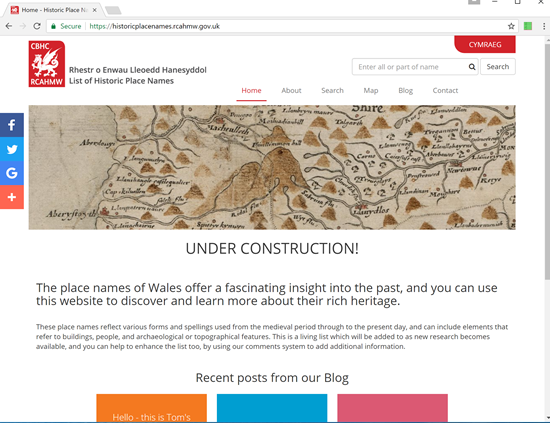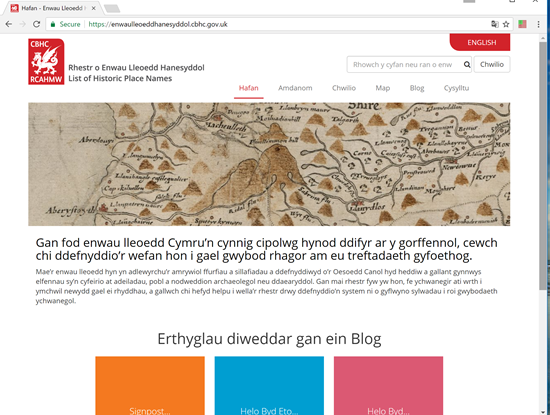Case Study: Historic Place Names of Wales
- Posted in:
- cloudscribe
In this post we will look at how using cloudscribe components helped deliver a high quality web project within a modest budget and allowed most effort to be focused on the primary project specific features we needed to develop.
I had the good fortune to collaborate as a sub contractor with Exegesis Spatial Data Management on this delightful project, for their client, Royal Commission on the Ancient and Historical Monuments of Wales (RCAHMW).
Main Project Goals
The main goal of the project was to provide an accessible and responsive web interface onto a new database of historic place names in Wales, including Google-like searching and interactive maps. At the time of this writing the main features are complete but the dataset of around 400,000 place-names is still being improved and added to, working towards a public launch on May 8, 2017. As a project for the Welsh Government, another high priority was that all public facing features and content in the site should be available in both English and Welsh languages. Actually, while it is conceptually one site there are 2 domains that correspond to the English version, and the Welsh version, with a language switcher at the top of each site designed to link to the corresponding page in the other site. This was implemented as a single web application with 2 tenant sites using the multi-tenancy feature of cloudscribe Core. This was ideal since both sites have the exact same features and use the same codebase, while each tenant is configured with the corresponding language and localization.
Secondary Project Goals
As with most website projects, there are some standard features that most projects need such as a few marketing and informative pages, a contact form, a blog, social sharing, etc. Most of these needs were met with free open source cloudscribe components, for social sharing we used AddThis, and for comments we used Disqus. I should note that as the primary developer of the cloudscribe components, I was able to use the lessons learned and feedback from the team on the Place Names of Wales project to make these components even better.
Specific cloudscribe Components used in this project
- cloudscribe.Core - for user accounts and role management
- cloudscribe.SimpleContent - for pages and blog posts that are easy to edit right in the web browser
- cloudscribe.SimpleContactForm - for you guessed it, a contact form
- cloudscribe.Web.Localization - for easier localization and customization of labels, buttons, instructions, etc
- cloudscribe.Web.Navigation - for menus and breadcrumbs
- cloudscribe.Web.Pagination - for generating links for paged data
- cloudscribe.Logging - for capturing and browsing log events
- cloudscribe.DbHelpers - was used for easier data access against our back end stored procedures for the search and mapping data
That is a lot of ready to use functionality that you would not want to have to build from scratch for every project, and you don't have to.
The project team at Exegesis found that working with the cloudscribe components was straightforward and logical and helped them learn the new ASP.NET Core technology along the way, while the site administrators at RCAHMW found the creation and editing of content simple and intuitive.
We started the project using one of the cloudscribe StarterKits, which are basically reference applications that provide examples of how to wire up the cloudscribe components in various configurations. Then we developed custom code for the primary features and language switching, and the visual design to meet the needs of the client.
The language switching was an interesting challenge since there are 2 separate sites even though they are running from the same installation. Our first implementation automated it for blog posts by using the date and sequence of the post to match the corresponding post in the other site, so as long as posts were added on the same date and sequence in both sites, we could find the corresponding post in the other site to link to. We had some mapping for the pages from configuration which was ok given that the project only envisioned a small number of pages. Then after further consideration and thinking that the language switching might be a common challenge also in future projects, we pondered how to make it better and I pondered how to better support it in cloudscribe SimpleContent. As a result of that process, I added a new "correlation key" field for pages and blog posts. The idea is that though pages and posts in each site will have different titles and urls corresponding to the given language, a correlation key could be used to relate the content from each site and the corresponding page or post could be looked up using the correlation key. The new solution does require that the correlation key is populated in order to be able to find the content in the other site, but is a more reliable way to tie the content together.
In summary, by using the cloudscribe components we were able to focus most of the effort towards the primary custom features required by the client. The end result is a high quality web application running on a modern technology stack, delivered on a modest budget. The client is happy and the team enjoyed the project.

